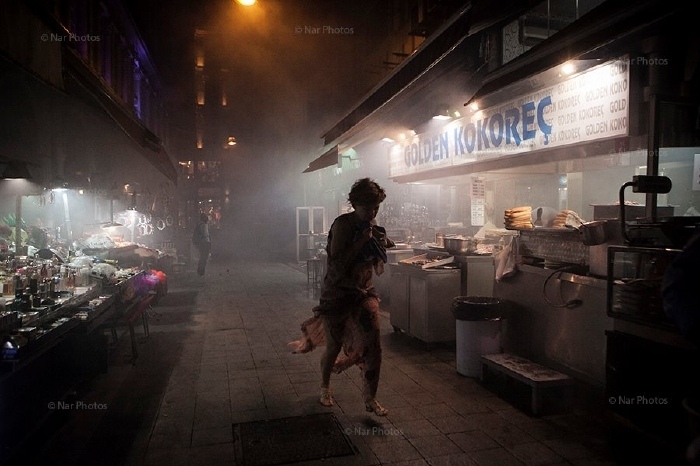Nar Photos: Taking a stand at the Gezi protests behind the camera lens
by RUMEYSA KIGER, Istanbul first published at Today’s Zaman June 23

Founded in 2003, Nar Photos is an independent collective with the aim of “understanding and expressing” the world. With their 16 photographers they have been documenting the protests in Turkey 2013 since the very beginning and sharing their images through online social networks.
Having captured some of the best images of the protest movement, Nar Photos stood out from many of the Turkish press groups that have been fiercely criticized for downplaying the events or explicitly siding with the government against the protests.
Nar Photos is a collective consisting of photographers who share a similar political worldview rather than a commercial collaboration employing professional photographers, the members of the group said in an interview. “As a volunteer collaboration, our basic motivation is to understand the social transformation that encircles us and record it as much as our resources and energy allow. The social structure of Turkey is vastly open to any kind of transformation and unexpected developments, as we have seen in this recent process. It is possible to say that from the very beginning of these recent events, a gradually pervading collective objection to any kind of imposition flourished, starting with the Gezi Park protest specifically. From the first days of the events, we had the moral and political goal of ‘correctly’ reflecting the images on the street that were connected to this social dynamic. We tried to truly transmit the spirit of the resistance … while avoiding the common tendency of trying to capture an exceptional image or show off the talent of the photographer,” the members explained.

Photography as activism
Many photographers who where attempting to document what was transpiring on the streets during the protests faced the dilemma of deciding whether to run away from police attacks or stay to photograph them, the group said. “Like many other photographers, sometimes we ran away from the pepper gas, sometimes we stayed and photographed it. Insisting on only always adopting the same approach wouldn’t help anyone,” the photographers added.
Asked whether, given their support for the protests, they ever felt conflicted over the question of joining in the events or documenting — of chanting slogans or photographing people who are chanting slogans — the members of Nar Photos say that it is only if activism were defined solely as chanting slogans that a photographer would have to choose one or the other. “However, if we liberate activism from this duality and grasp it in another way, it is absolutely possible to have an activist attitude, to attempt to truly reflect the spirit of the event you are documenting, to showcase it on the right platforms without taking it out of its context and to make an effort to open a debate regarding the thing you are witnessing, rather than your own adventure,” they said, stressing that there were many more than two choices available to them.

Dealing with police while documenting
Among the many videos shot during the events on the streets, there were also some in which police forced individuals to stop photographing or recording. Asked whether they have experienced similar problems, the photographers explain that the attitude of the police toward the photographers is the last link in the chain of the state’s pressure mechanism and that it would be better to understand the situation by starting from the beginning of this hierarchy. “If we trace the chain back, the attitudes and gradually stiffening speeches of the chief of the police, the governor, the interior minister and finally the prime minister were the source of the problems we encountered with the police as individuals of the press. At every step of the hierarchy, starting from the very top, the increasingly toughening discourse was reflected on the streets in the form of increased violence from the police — and reporters got their own share of this as well,” they emphasized.
But however such incidents are interpreted, the collective saw many of them. “From the very beginning of the events, we were the living witnesses of numerous situations in which our friends from the press were either intentionally or indirectly targeted and eventually couldn’t even operate. There were some who were shot in the head with the tear gas capsules, targeted with plastic bullets, detained after being beaten in the middle of the street, detained because they did not have press cards, etc. Those who are interested can read the report on Turkey by Reporters Without Borders to see the recorded violations against reporters name by name,” they noted.

Photographs as evidence
One of the advantages and also disadvantages of documenting such events with photographs is the ability to use them as evidence; they can be evidence both of police violence and of individuals participating in the protests who could subsequently be targeted by the government for their involvement. “This is a controversial issue for many photographers who take the issue they are photographing seriously. We all know images that caused troubles for the subjects from history. We also know that from time to time, the reasons a photograph was taken and the way it was ultimately used can be completely different. … Our aim is not to reveal [the identities of] the people who were in the squares demanding their rights, continuing their demonstrations in a peaceful manners and resisting violence, but to document their cause and their resistance. On the other hand, we all witnessed while following the events that the state did not make any effort to hide the disproportional violence it used. If we really wanted find evidence of physical violence and rights violation, it would be extremely easy to find visual proof,” the photographers stressed.

Read the full article at Today’s Zaman
More Infos: Occupy Gezi Park – How it starts

